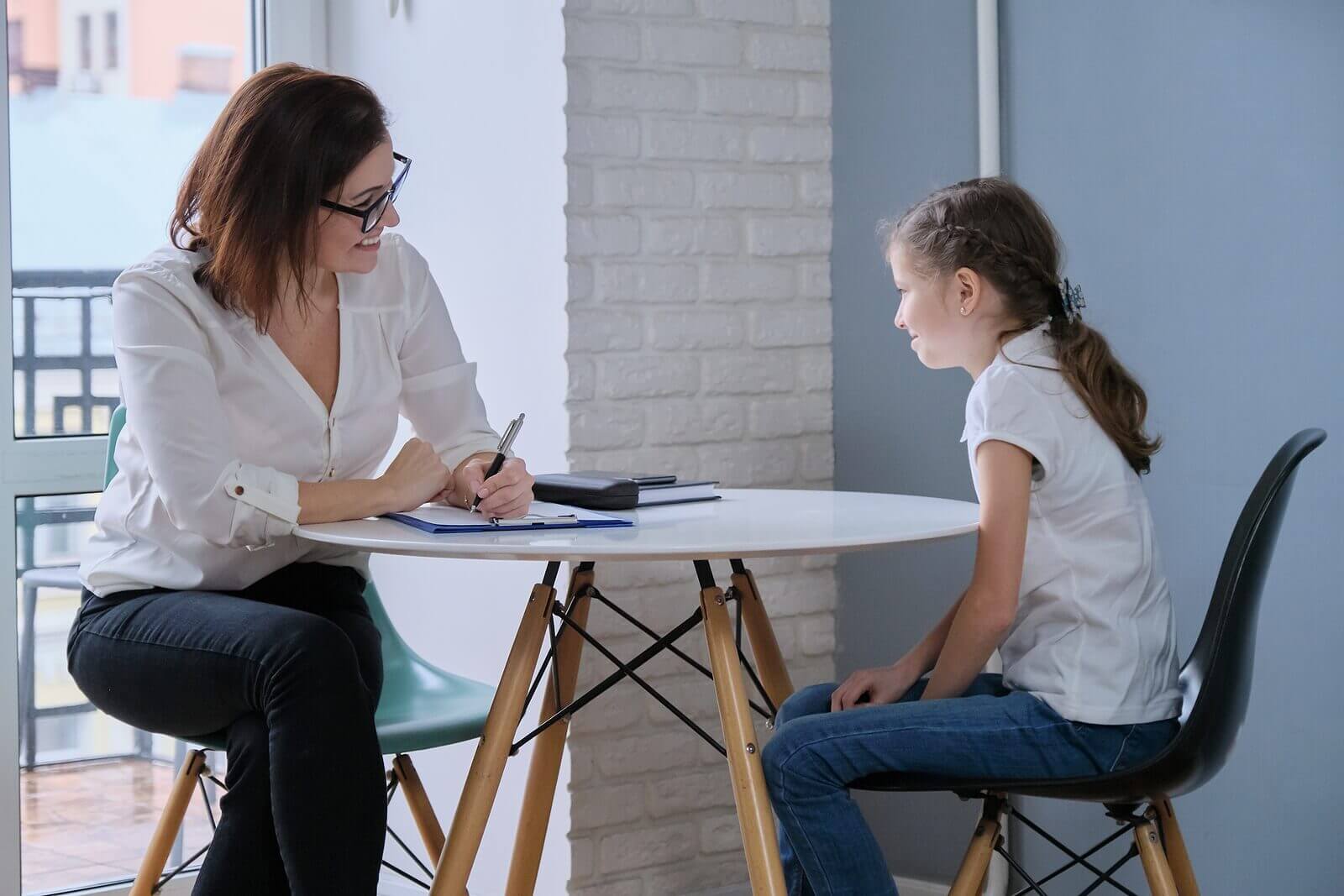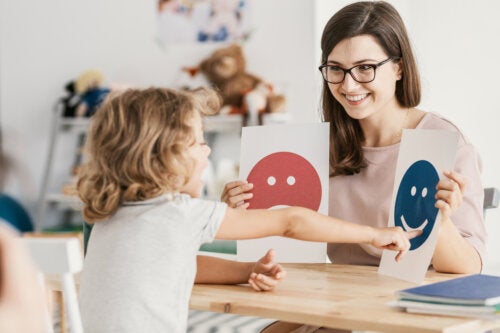What Is the Therapeutic Alliance in Children and Adolescents?


Written and verified by the psychologist Elena Sanz Martín
“Know all the theories, master all the techniques, but as you touch a human soul be just another human soul.” This famous phrase, pronounced by Carl Gustav Jung, is the perfect definition and the propitious call of attention regarding the “therapeutic alliance.”
This is the relationship of trust that’s forged by which the patient trusts their therapist, can open up to them, and is willing to work together with them. But does the therapeutic alliance exist in children and adolescents? And how is it built in this case?
It can feel like a “connection with the professional.” Surely, as a parent, one of your biggest concerns is, “Will my child feel comfortable during their therapy sessions?” The truth is that there are different techniques and strategies aimed at making this happen in child and adolescent psychotherapy.

What’s the therapeutic alliance?
It’s a mutual partnership in which both participants work together to achieve therapeutic goals and the emotional well-being of the patient. The intent is to create a safe, empathic, and non-judgmental environment where the patient feels comfortable sharing their thoughts, feelings, and experiences. Its three main objectives are as follows:
- To achieve a positive therapist-patient connection. This is achieved when the former adopts an attitude of unconditional acceptance and absolute respect for the experiences of the latter.
- Reaching an agreement on goals. Both people have to agree on what goals they want to achieve and move toward them together.
- Reaching agreement on tasks. It’s also important that both agree on the techniques, tasks, or exercises to be performed and that there’s no doubt.
To achieve all of the above, psychologists and therapists are trained in a series of techniques such as active listening, empathy, flexibility, and communication strategies. This offers great results, as it has been seen that the therapeutic alliance could be the determining factor in the success of a therapy.
However, connecting with children and adolescents isn’t the same as connecting with adults. Therefore, those working with the child and adolescent population need to adapt procedures. As a parent, knowing this can be reassuring because you can be sure that the professional will know how to address your child and how to cultivate an age-appropriate bond with them.
The therapeutic alliance with children and adolescents
This type of population has different characteristics than adults and, therefore, also poses a series of challenges. Therefore, in order to create a therapeutic alliance with children and adolescents, a series of special requirements must be met.
Training in child and adolescent psychology
If you decide to take your child to a psychologist’s office, you should know that this professional will have specific training in developmental psychology. In other words, they’ll have an in-depth knowledge of the main stages of development and their processes.
This will allow them to understand the child’s behaviors, know what tools to use and, above all, create a good therapeutic alliance with them.
Motivation
It’s important to understand that children and adolescents don’t usually come to psychological consultations of their own free will but that it’s the adults in charge who make this decision for them.
Therefore, at first, your child may not understand well what they’re doing there, what’s going to happen, or what the purpose or usefulness of therapy is. They may feel fear or rejection or may not be very willing to collaborate. However, the professional working with children understands this situation and takes the appropriate measures to approach them and motivate them appropriately.
Communication
Another distinctive element in these cases, especially in younger children, is communication. Children may not have the same verbal repertoire or the same cognitive capacity as an adult to reflect on their thoughts or emotions and know how to convey them.
Fortunately, if you go to a child psychologist, they’ll understand how to communicate at each stage of development and will know alternative means to verbal language through which your child can express and understand.
Communication with parents
A final fundamental point refers to the fact that children and adolescents are dependent beings. It’s their parents who are responsible for them and, therefore, they have to be informed and make decisions.
In this regard, the professional you go to will know how to deal with you and your partner, understand the family system as a whole, and encourage you to participate in your child’s process as necessary.
Strategies to generate a therapeutic alliance

Bearing in mind all the above, and according to an article published in the Revista Chilena de Psiquiatría y Neurología de la Infancia y Adolescencia, there are certain strategies and behaviors that the therapist usually follows in order to generate this bond.
- Maintaining a playful attitude during the process and using age-appropriate strategies. For example, with younger children, it’s very useful to use stories, dance, or play as assessment and intervention tools(Bernal & Silva, 2014).
- Encouraging hope and motivation.
- Creating an emotional connection with the child or adolescent.
- Finding common interests.
- Maintaining a language adjusted to the child’s age.
- Avoiding breaking promises.
- Not putting pressure on the child to talk when they do not want to do something.
The importance of the therapeutic alliance in the therapy of children and adolescents
In short, in order to carry out a good therapeutic process with children and adolescents, it’s essential to establish an adequate therapeutic alliance with them. This is based on emotional connection, complicity, and trust, which is what makes it possible for the child to open up to express their inner world and collaborate in achieving the proposed goals.
However, as we’ve seen, it’s crucial that the professional is trained in child and adolescent psychology and has a deep knowledge of the stages of growth and a clear vocation in this field.
These are aspects that you have to look at when selecting the right professional to accompany your child. If they’re able to establish a good bond, the success of the intervention is much more likely to take place.
“Know all the theories, master all the techniques, but as you touch a human soul be just another human soul.” This famous phrase, pronounced by Carl Gustav Jung, is the perfect definition and the propitious call of attention regarding the “therapeutic alliance.”
This is the relationship of trust that’s forged by which the patient trusts their therapist, can open up to them, and is willing to work together with them. But does the therapeutic alliance exist in children and adolescents? And how is it built in this case?
It can feel like a “connection with the professional.” Surely, as a parent, one of your biggest concerns is, “Will my child feel comfortable during their therapy sessions?” The truth is that there are different techniques and strategies aimed at making this happen in child and adolescent psychotherapy.

What’s the therapeutic alliance?
It’s a mutual partnership in which both participants work together to achieve therapeutic goals and the emotional well-being of the patient. The intent is to create a safe, empathic, and non-judgmental environment where the patient feels comfortable sharing their thoughts, feelings, and experiences. Its three main objectives are as follows:
- To achieve a positive therapist-patient connection. This is achieved when the former adopts an attitude of unconditional acceptance and absolute respect for the experiences of the latter.
- Reaching an agreement on goals. Both people have to agree on what goals they want to achieve and move toward them together.
- Reaching agreement on tasks. It’s also important that both agree on the techniques, tasks, or exercises to be performed and that there’s no doubt.
To achieve all of the above, psychologists and therapists are trained in a series of techniques such as active listening, empathy, flexibility, and communication strategies. This offers great results, as it has been seen that the therapeutic alliance could be the determining factor in the success of a therapy.
However, connecting with children and adolescents isn’t the same as connecting with adults. Therefore, those working with the child and adolescent population need to adapt procedures. As a parent, knowing this can be reassuring because you can be sure that the professional will know how to address your child and how to cultivate an age-appropriate bond with them.
The therapeutic alliance with children and adolescents
This type of population has different characteristics than adults and, therefore, also poses a series of challenges. Therefore, in order to create a therapeutic alliance with children and adolescents, a series of special requirements must be met.
Training in child and adolescent psychology
If you decide to take your child to a psychologist’s office, you should know that this professional will have specific training in developmental psychology. In other words, they’ll have an in-depth knowledge of the main stages of development and their processes.
This will allow them to understand the child’s behaviors, know what tools to use and, above all, create a good therapeutic alliance with them.
Motivation
It’s important to understand that children and adolescents don’t usually come to psychological consultations of their own free will but that it’s the adults in charge who make this decision for them.
Therefore, at first, your child may not understand well what they’re doing there, what’s going to happen, or what the purpose or usefulness of therapy is. They may feel fear or rejection or may not be very willing to collaborate. However, the professional working with children understands this situation and takes the appropriate measures to approach them and motivate them appropriately.
Communication
Another distinctive element in these cases, especially in younger children, is communication. Children may not have the same verbal repertoire or the same cognitive capacity as an adult to reflect on their thoughts or emotions and know how to convey them.
Fortunately, if you go to a child psychologist, they’ll understand how to communicate at each stage of development and will know alternative means to verbal language through which your child can express and understand.
Communication with parents
A final fundamental point refers to the fact that children and adolescents are dependent beings. It’s their parents who are responsible for them and, therefore, they have to be informed and make decisions.
In this regard, the professional you go to will know how to deal with you and your partner, understand the family system as a whole, and encourage you to participate in your child’s process as necessary.
Strategies to generate a therapeutic alliance

Bearing in mind all the above, and according to an article published in the Revista Chilena de Psiquiatría y Neurología de la Infancia y Adolescencia, there are certain strategies and behaviors that the therapist usually follows in order to generate this bond.
- Maintaining a playful attitude during the process and using age-appropriate strategies. For example, with younger children, it’s very useful to use stories, dance, or play as assessment and intervention tools(Bernal & Silva, 2014).
- Encouraging hope and motivation.
- Creating an emotional connection with the child or adolescent.
- Finding common interests.
- Maintaining a language adjusted to the child’s age.
- Avoiding breaking promises.
- Not putting pressure on the child to talk when they do not want to do something.
The importance of the therapeutic alliance in the therapy of children and adolescents
In short, in order to carry out a good therapeutic process with children and adolescents, it’s essential to establish an adequate therapeutic alliance with them. This is based on emotional connection, complicity, and trust, which is what makes it possible for the child to open up to express their inner world and collaborate in achieving the proposed goals.
However, as we’ve seen, it’s crucial that the professional is trained in child and adolescent psychology and has a deep knowledge of the stages of growth and a clear vocation in this field.
These are aspects that you have to look at when selecting the right professional to accompany your child. If they’re able to establish a good bond, the success of the intervention is much more likely to take place.
All cited sources were thoroughly reviewed by our team to ensure their quality, reliability, currency, and validity. The bibliography of this article was considered reliable and of academic or scientific accuracy.
- Bernal, Á., & Silva, T. (2014). Juego, danza y música en psicoterapia infantil. Praxis Pedagógica, 14(15), 255-265.
- Corbella, S., & Botella, L. (2003). La alianza terapéutica: historia, investigación y evaluación. Anales de Psicología/Annals of Psychology, 19(2), 205-221. https://revistas.um.es/analesps/article/view/27671
- Herrero, L. E. (2018). Alianza terapéutica en psicoterapia infantil. Propuesta de una escala de
evaluación. [Tesis de pregrado]. Repositorio Institucional – Universidad Pontificia
Comillas. https://repositorio.comillas.edu/rest/bitstreams/141369/retrieve - Lambert, M. J., & Barley, D. E. (2001). Research summary on the therapeutic relationship and psychotherapy outcome. Psychotherapy: Theory, research, practice, training, 38(4), 357.
- Vargas Gallegos, B., Gumucio Dobbs, F., & González Guevara, C. (2015). Efectividad en intervenciones terapéuticas con niños y adolescentes: Factores asociados a la Persona del Terapeuta y la Alianza Terapéutica. Rev. chil. psiquiatr. neurol. infanc. adolesc.(Impr.), 10-17.
This text is provided for informational purposes only and does not replace consultation with a professional. If in doubt, consult your specialist.








